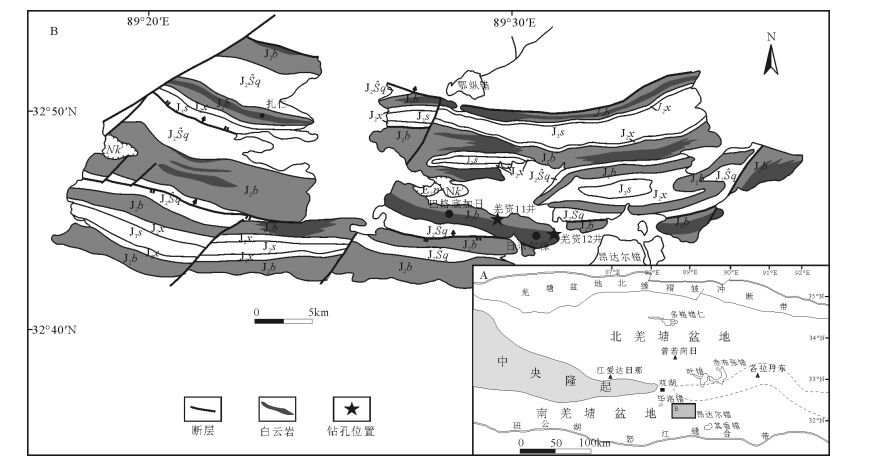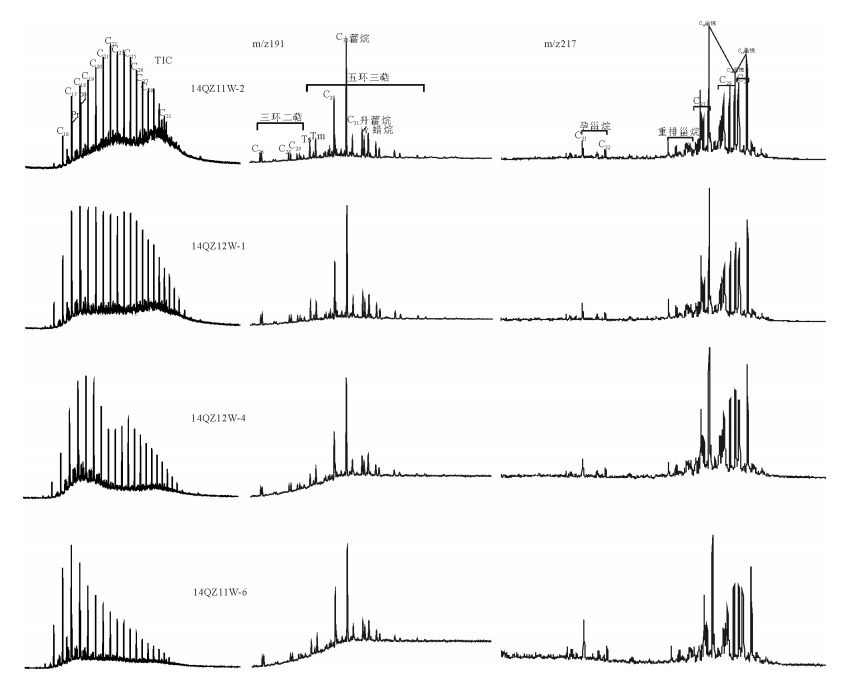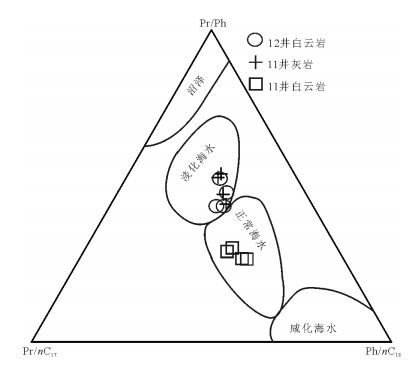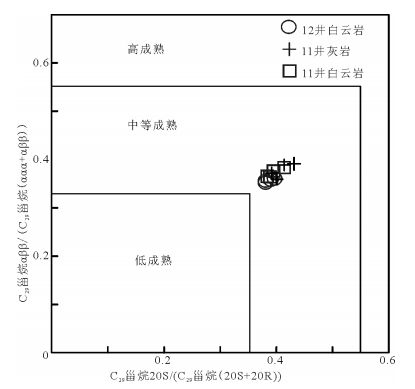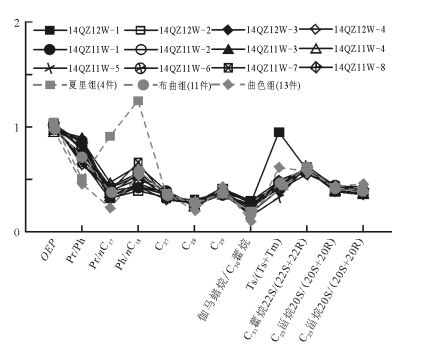Geochemical features of oil-bearing samples from the well in Buqu Formation in the Qiangtang Basin, northern Tibet, and their implications
-
摘要:
羌资11、12井是羌塘盆地揭示隆鄂尼-昂达尔错古油藏展布规律的资料井。对这2口钻井揭示的含油岩层进行取样分析,结合前人该区石油地质调查报告中羌资2井布曲组、夏里组及曲色组烃源岩的分析数据,从类异戊二烯烃、甾烷、萜烷等系列生物标志化合物参数方面进行油-岩对比研究。研究表明,羌资11、12井揭示的原油为同一种类型,但11井原油生物降解程度强于12井。各原油的母质主要来源于低等水生生物和藻类;各原油的母质形成于还原-弱还原、盐度值不高的咸水环境。原油中类异戊二烯烃、萜烷、甾烷等生物标志化合物参数与羌资2井布曲组泥晶灰岩与夏里组和曲色组烃源岩之间具有较好的亲缘性。结合南羌塘地区烃源岩有机碳资料,油源可能主要来自于曲色组,混入了部分夏里组及布曲组的油源,具有混源的特征。该研究结果对下一步油气勘探具有一定的指导意义。
Abstract:The Qiangzi-11 and 12 wells are the data well to reveal the distribution regularities of Longeni-Angdaerco palaeo-oil reservoirs. Together with the hydrocarbon source rock data of Buqu Formation, Xiali Formation, and Quse Formation from Qiangzi-2 well, the authors analyzed the oil-rock correlations based on the biomarker parameters composed of isoprenoid, steranes, and ter-panes. The property of crude oil from Qiangzi-11 and 12 wells is of the same type. However, the biodegradation degree from Qiang-zi-11 well is higher than that from Qiangzi-12. The biomarker parameters reveal that the organic matter mainly originated from al-gae. The crude oil was formed under weak reduction-reduction conditions and in a slightly salty water environment. The biomarkers of crude oil, composed of isoprenoid, terpane, and sterane, are closely related to those of the Buqu Formation in Qiangzi-2 well, and also show good correlation with those of the Xiali Formation and Quse Formation in Qiangzi-2 well. Combined with the TOC data of the hydrocarbon source rock in south Qiangtang Basin, the authors hold that the crude oil of the Longeni-Angdaerco palaeo-oil reservoir was mainly from the source rocks of Quse Formation, and partly from the Xiali and Buqu Formations, suggesting a mixture of sources. The result of this study may have some guidance significance for further oil-gas exploration.
-
Keywords:
- biomarker /
- oil-bearing dolomite /
- Buqu Formation /
- oil-rock correlation /
- Qiangtang Basin
-
福建沿海因其地处欧亚大陆板块东南缘, 东临太平洋板块, 易受全球构造影响, 为岩浆活动最活跃的地区之一。新生代以来受喜马拉雅运动影响, 南海海盆扩张引发了中国东南沿海一系列的火山活动, 福建沿海也是主要受影响区域之一[1]。福建省火山岩十分发育, 新元古代—新近纪主要有4个活动时期, 包括新元古代、石炭纪、中生代及上新世[2], 其中新生代玄武岩主要分布在闽东南沿海漳浦佛昙—龙海镇海一带, 以及闽中、闽西的明溪、泰宁、宁化等地[3]。龙海—漳浦沿海区域的喜马拉雅旋回火山岩, 是上地幔经过部分熔融喷发至地表形成的, 属于板块间构造运动-岩浆活动的产物[4-7], 是研究构造活动时代、火山喷发与环境演变的重要线索。龙海—漳浦沿海地区在地质构造上位于长乐-南澳断裂带南段, 区域内玄武岩循断裂喷溢是前人已经达成的共识, 中生代玄武岩测年结果以锆石U-Pb为主[8-14]。新生代玄武岩喷溢时代的确定和期次划分仍然以20世纪八九十年代的K-Ar数据为主要依据[3, 15-21]。近年来, 随着测年技术的发展, 40Ar/39Ar方法已成为精确测定火山岩喷发时限的有效和精准途径之一[22-25], 精确的测定与划分福建东南沿海一带火山岩的喷发时代与期次, 能为进一步了解该研究区新生代地球动力学演化, 以及未来的环境演变、地质灾害调查提供重要的基础地质依据。
1. 地质背景
福建省位于华南褶皱系东部, 地层出露较全, 多期次侵入岩、火山岩、变质岩广泛发育, 其中火山岩十分发育。新生代玄武岩主要分布在闽东南沿海漳浦佛昙—龙海镇海一带, 龙海天马山、流会地区的石英拉斑玄武岩K-Ar同位素年龄为16.57~ 19.26Ma, 为中新世[3]。另外, 新生代玄武岩在闽中、闽西的明溪、泰宁、宁化等地也有少许分布, 明溪地区玄武岩K-Ar同位素年龄为4.96~0.72Ma, 时代为上新世晚期—更新世早期[3]。
构造位置上, 龙海—漳浦地区整体位于闽东南长乐-南澳断裂带的南段, 该断裂带北起福州市长乐区, 南至汕头市南澳县, 总体呈NE向平行福建省海岸线分布, 宽38~58km, 长约400km。断裂带主要由长乐-建设断裂、三山-诏安断裂、平潭-南澳断裂3条NE向次级断裂带组成(图 1)。以三山-诏安断裂为界, 东侧出露中、深构造层次变形的变质岩系, 西侧出露中、浅构造层次变形的火山碎屑-沉积岩、侵入岩。长乐-南澳断裂推测发生于晚三叠世, 由于太平洋板块向欧亚大陆板块俯冲, 在福建大陆边缘平行俯冲带形成长乐-南澳断裂带, 其在中生代是一条陆内大型韧性剪切带, 白垩纪该断裂带仍强烈活动, 造成花岗岩大规模沿断裂带侵入, 并有超基性和基性岩分布。新近纪至今, 该断裂带控制新近系佛昙群玄武岩层和近代地震及温泉的分布[1, 26-29]。
![]() 图 1 长乐-南澳断裂带分布位置[26]Figure 1. Sketch map showing the location of Changle-Nan'ao fault zone
图 1 长乐-南澳断裂带分布位置[26]Figure 1. Sketch map showing the location of Changle-Nan'ao fault zone研究区主要分布在三山-诏安断裂、平潭-南澳断裂带2条次级断裂带内, 平潭-南澳断裂带自北部大小金门向西南经镇海、流会、牛头山延伸至东山澳角, 走向NE40º左右, 倾向以SE为主, 倾角70º~ 85º, 长百余千米, 呈NE向带状展布(图 2), 属环太平洋火山带的一部分[30-32]。龙海—漳浦出露的玄武岩属于佛昙群, 主要指一套含新生代玄武质火山岩和其下的地层, 属火山喷发陆相山间盆地沉积, 该地层不整合于白垩纪黑云母花岗岩或片麻状混合岩之上, 一般厚110~330m, 包括上、中、下三部分, 龙海—漳浦一带主要出露下部和中部, 中部主要为一套海陆交互相基性火山岩[2]。郑晓云等[15]对佛昙群的5个露头剖面进行了野外考察和样品测试, 将其地质时代定为渐新世晚期—中更新世中期。
与龙海—漳浦沿海火山岩的地球化学特征、岩浆的形成演化研究相比, 前人对该区火山岩, 特别是新生代火山岩的年龄测试成果集中在20世纪八九十年代(表 1), 且以K-Ar测年结果为主[3, 15, 17-18, 33-34]。近年来, 随着激光40Ar/39Ar测年方法精度和准确度的提高[22], 进一步厘定新生代火山岩的喷发时限, 明确其喷发期次, 能够为进一步了解龙海—漳浦沿海主要断裂构造活动性提供时代依据。
表 1 龙海—漳浦地区火山岩K-Ar年龄数据Table 1. Chronology statistic data of volcanic rocks in Longhai-Zhangpu area序号 采样地点 岩性 年龄/Ma 资料来源 1 漳浦佛昙 玄武岩 24.0 [16] 2 漳浦赤湖将军澳 玄武岩 27.2±0.5 [17] 3 龙海天马山 拉斑玄武岩 19.2±0.56 [3] 4 龙海天马山 碱性玄武岩 18.0±0.49 [3] 5 龙海天马山 拉斑玄武岩 16.57±0.57 [3] 6 龙海牛头山 碱性玄武岩 16.7±0.56 [3] 7 龙海流会 橄榄玄武岩 17.58±0.49 [3] 8 龙海流会 橄榄玄武岩 18.05±0.78 [3] 9 龙海香山 橄榄玄武岩 17.68±0.51 [3] 10 龙海香山 橄榄玄武岩 17.52±0.54 [3] 11 漳浦后陈山山顶 玄武岩 16.6±0.3 [17] 12 龙海镇海 玄武岩 17.1 [17] 13 漳浦佛昙镇鱼鳞坑 玄武岩 17.1±0.3 [17] 14 龙海牛头山 火山口外缘玄武岩 11.65±0.44 [18] 15 福建漳浦佛昙 石英拉斑玄武岩 10.04±0.71 [33] 16 龙海牛头山 火山口附近粗玄岩 1.62±0.24 [17] 17 龙海流会潮间带 玄武岩 1.48±0.03 [17] 18 龙海镇海关头 玄武岩 1.07±0.37 [15] 19 龙海镇海关头 玄武岩 0.7 [17] 2. 样品采集和测试
2.1 岩石样品采集和前期处理
样品主要采自流会、牛头山、天马山、香山一带, 采集玄武岩样品22件, 具体采样点位置和信息见图 2和表 2。首先对前21件样品进行主量元素测定, 测得该区火山岩全岩K含量在2.49%~0.20%之间, SiO2含量为45%~53%(表 3)。SiO2-(Na2O+ K2O)图解显示, 大部分样品属于亚碱性系列(图 3)。
表 2 龙海—漳浦地区玄武岩野外采样信息Table 2. Basalt information of Longhai-Zhangpu area序号 样品名 采样地点 采样位置 岩性 1 DHK1-1 顶后坑 E118°01′18"
N24°13′57″气孔状玄武岩 2 DHK1-2 顶后坑 E118°01′18"
N24°13′57″玄武岩 3 FT-3 佛昙龙船山 E117°52′50″
N24°09′37″橄榄玄武岩 4 GT-2 关头 E118°04′57"
N24°15′56″杏仁状玄武岩 5 JJ1-1 将军澳 E117°52′58"
N24°02′20″气孔状玄武岩 6 LH1-1 流会 E118°07′26"
N24°16′40″杏仁状橄榄玄武岩 7 LH1-2 流会 E118°07′46"
N24°16′10″杏仁状玄武岩 8 QH1-1 前湖 E117°53′9"
N24°07′23″橄榄玄武岩 9 XS-1 香山 E118°01′7"
N24°13′21″蚀变杏仁状橄榄玄武岩 10 XS-2 香山 E118°01′7"
N24°13′21″杏仁状玄武岩 11 YP-1 洋坪 E118°02′57"
N24°14′35″杏仁状橄榄玄武岩 12 YPL-3 洋坪岭 E118°03′2"
N24°14′25″橄榄玄武岩 13 QH 前湖 E117°53′24"
N24°06′44″安山玄武岩 14 JJA 将军澳 E117°52′54"
N24°02′09″玄武岩 15 ft-1 佛昙 E117°52′51"
N24°09′37″橄榄玄武岩 16 GT 关头 E118°05′03"
N24°16′0″杏仁状玄武岩 17 ft-2 佛昙 E117°52′52"
N24°09′06″橄榄玄武岩 18 LH-1 流会 E118°07′26"
N24°16′40″杏仁状玄武岩 19 TMS 天马山 E117°59′25"
N24°11′51″玄武岩 20 ZHC 镇海村 E118°05′13"
N24°15′14″玄武岩 21 ZHW 镇海卫 E118°05′31"
N24°15′39″玄武岩 22 YLS 鱼鳞石场 E118°52′41"
N24°11′44″玄武岩 表 3 龙海—漳浦地区新生代火山岩主量元素含量Table 3. Major element contents of Cenozoic volcanic rocks in Longhai-Zhangpu area% 序号 样品名 SiO2 TiO2 Al2O3 Fe2O3 MnO MgO CaO Na2O K2O P2O5 总计 K 1 DHK1-1 52.49 1.7 14.77 11.44 0.13 5.8 8.91 2.63 0.49 0.23 98.59 0.41 2 DHK1-2 52.56 1.33 15.38 10.1 0.13 6.68 9.45 2.61 0.45 0.18 98.87 0.37 3 FT-3 50.6 2.51 14.67 12.14 0.15 5.74 7.71 2.87 1.43 0.58 98.40 1.19 4 GT-2 51.55 1.15 15.69 10.37 0.13 7.03 9.61 2.31 0.28 0.14 98.26 0.23 5 JJ1-1 53.8 1.5 14.8 10.61 0.13 6.52 8.66 2.65 0.26 0.14 99.07 0.22 6 LH1-1 48.45 1.72 13.97 12.16 0.17 7.9 8.68 2.78 1.01 0.33 97.17 0.84 7 LH1-2 46.99 1.72 14.07 11.2 0.16 5.11 10.19 2.75 0.79 0.33 93.31 0.66 8 QH1-1 50.92 2.21 14.68 12.27 0.14 6.43 7.91 2.79 1.25 0.46 99.06 1.04 9 XS-1 51.68 1.73 14.81 11.19 0.15 6.59 9.2 2.8 0.55 0.24 98.94 0.46 10 XS-2 51.92 1.3 15.05 10.1 0.11 7.93 8.53 2.34 0.27 0.17 97.72 0.22 11 YP-1 49.72 2.06 14.52 10.36 0.13 6.94 6.96 3.16 3 0.54 97.39 2.49 12 YPL-3 48.88 2.47 14.4 11.29 0.13 7.17 6.62 4.08 2.05 0.52 97.61 1.70 13 QH 51.09 2.63 14.89 11.75 0.134 5.85 7.49 2.92 1.62 0.599 98.97 1.34 14 JJA 51.22 1.47 14.02 12.72 0.515 5.97 8.46 2.47 0.212 0.139 97.20 0.18 15 ft-1 49.95 2.55 14.46 12.34 0.168 5.87 7.61 2.72 1.36 0.561 97.59 1.13 16 GT 49.28 1.13 14.89 10.26 0.257 5.51 11.2 2.33 0.226 0.147 95.23 0.19 17 ft-2 50.75 2.72 14.6 11.86 0.141 5.78 7.49 2.88 1.67 0.61 98.50 1.39 18 LH-1 48.58 1.69 13.58 12.51 0.148 8.17 8.52 2.64 0.661 0.31 96.81 0.55 19 TMS 49.46 1.26 15.24 10.18 0.097 6.74 8.52 2.17 0.241 0.153 94.06 0.20 20 ZHC 48.22 1.47 15.06 12.65 0.153 7.36 9.35 2.67 0.498 0.217 97.65 0.41 21 ZHW 51.5 2 14.64 11.64 0.14 7.06 8.05 2.88 1.26 0.385 99.56 1.05 2.2 岩石学特征
本次对研究区玄武岩的岩相特征进行了研究, 火山岩主要由基性熔岩和少量火山碎屑岩组成。基性熔岩主要包括玄武岩和少量安山玄武岩, 玄武岩主要为典型的气孔状、杏仁状及块状玄武岩, 以橄榄玄武岩为主。岩石多呈暗灰色、灰绿色, 致密块状构造为主, 具斑状-基质间粒结构(图 4-a)或似辉绿结构(图 4-b)。矿物组分主要为斜长石(50%~ 60%)、单斜辉石(25%~35%)、橄榄石(15%~45%)等。斑晶以斜长石和橄榄石为主(图 4-c、d)。基质为斜长石、辉石、橄榄石及玻璃质。
2.3 测试样品制备
本文选择4件(YLS、LH1-2、GT-2、FT-3)新鲜无蚀变的岩石样品进行碎样, 制成60~80目(0.25~ 0.18mm)的样品粉末。其中, 挑选样品剔除斑晶后的基质作为测试对象。
对样品进行去离子水和丙酮超声波清洗之后, 根据样品地质背景估计的年龄和K含量, 将0.18~ 0.28mm粒径样品用自制的高纯铝罐包装, 封闭于石英玻璃瓶中, 2014年5月8日至9日置于中国原子能科学研究院49-2反应堆B4孔道进行中子照射, 照射时间为24h, 快中子通量为2.2464×1018。用于中子通量监测的样品是中国周口店K-Ar标准黑云母(ZBH-25, 年龄为132.7Ma)[35]。同时对纯物质CaF2和K2SO4进行同步照射, 得出的校正因子参见数据。
2.4 实验设备和实验方法
照射后的样品冷置后, 在显微镜下, 以每个样品仓10~20个颗粒分别转移到20多个样品仓中, 系统密封后, 样品仓150℃、纯化系统200℃以上去气72h。
样品测试由北京大学造山带与地壳演化教育部重点实验室完成, 由全时标全自动高精度高灵敏度激光40Ar/39Ar定年系统完成。该系统主要由激光熔样系统、纯化系统及其自动控制阀门、VG5400质谱氩同位素分离探测系统及计算机程序全自动控制系统四部分组成。
测定采用聚焦激光对单颗粒或多颗粒的矿物岩石样品进行一次性熔融。激光能量1.0~3.5W, 激光束斑直径为0.5mm。激光在5s内逐渐升温到1.0~ 3.5W, 升温后熔样释气时间持续40s。系统分2个阶段使用2个锆铝泵对释出气体进行纯化, 第一阶段纯化时间180s, 第二阶段60s。系统通过测量已知摩尔数的空气对5个氩同位素(40Ar、39Ar、38Ar、37Ar、36Ar)质量歧视进行日常监测, 进行校正, D值为1.0078±0.0003。基准线和5个氩同位素均使用电子倍增器进行13个循环测量。信号强度的测量采用电流强度测量法, 信号强度以纳安(nA)为单位记录。测量已知摩尔数的空气的氩同位素信号强度, 获得系统在电子倍增器单位增益下的绝对灵敏度为2.394×10-18mol/nA。通过绝对灵敏度可以将氩同位素信号强度由纳安(nA)换算为摩尔。电子倍增器增益(与法拉第杯测量信号强度的比值)为3000~4000倍。整个设备的平均本底水平为:40Ar= 0.00233046±0.000010019nA, 39Ar=0.00000606± 0.000000833nA, 38Ar=0.000000181±0.0000005878nA, 37Ar= 0.00000482±0.000000783nA, 36Ar=0.00001723± 0.000001492nA。
系统测试过程、原始数据处理、模式年龄和等时线年龄的计算均采用美国加州大学伯克利地质年代学中心AlanL.Denio博士编写的MASSSPEC (V.7.84)软件自动控制①。
3. 测试结果
研究区4个玄武岩的激光40Ar/39Ar定年结果见表 4、图 5、图 6。表 4显示, 4个样品的正、反等时线年龄高度一致, 数据结果较理想。
表 4 玄武岩样品信息和激光40Ar/39Ar定年结果Table 4. Sample information and the laser 40Ar/39Ar dating results of basalt样品号 表观年龄统计结果 反等时线年龄 正等时线年龄 推荐年龄/Ma 年龄/Ma MSWD 年龄/Ma 40Ar/36Ar MSWD 年龄/Ma 40Ar/36Ar MSWD LH1-2 12.5±1.3 5.31 12.3±0.5 295.7±0.5 5 12.2±0.8 295.7±0.5 5 12.3±0.5 GT-2 11.3±1.2 4.46 14.8±1.8 286±5 1.7 14.8±1.5 286±3 1.7 14.8±1.8 YLS 8.8±1.3 6.55 10.1±1.5 293.7±1.6 5.9 10.2±1.0 294±2 5.9 10.1±1.5 FT-3 10.1±0.3 3.79 12.0±0.8 285±4 2.5 12.0±0.8 286±4 2.5 12.0±0.8 LH1-2表观年龄为12.5±1.3Ma。反等时线年龄为12.3±0.5Ma, 初始值40Ar/36Ar为295.7±0.5。等时线年龄为12.2±0.8Ma, 初始值40Ar/36Ar为295.7± 0.5。反等时线年龄和等时线年龄较一致, 等时线年龄的误差更小。
GT-2表观年龄为11.3±1.2Ma。反等时线年龄为14.8±1.8Ma。等时线年龄为14.8±1.5Ma, 初始值40Ar/36Ar为286±3(MSWD=1.7), 数据点离散性较小。反等时线年龄和等时线年龄较一致, 等时线年龄的误差更小, 线性较好。
YLS表观年龄为8.8±1.3Ma。反等时线年龄为10.1±1.5Ma, 初始值40Ar/36Ar为293.7±1.6。等时线年龄为10.2±1.0Ma, 初始值40Ar/36Ar为294±2。反等时线年龄和等时线年龄较一致, 等时线年龄的误差更小。
FT-3表观年龄的概率统计为10.1±0.3Ma。反等时线年龄为12.0±0.8Ma, 初始值40Ar/36Ar为285±4。等时线年龄为12.0±0.8Ma, 初始值40Ar/36Ar为286±4。反等时线年龄和等时线年龄较一致, 等时线年龄的误差更小。
GT-2、YLS及FT-3三个样品的初始40Ar/36Ar值都不同程度地低于295, 表明3个样品都经历了不同程度的“氩丢失”过程, 导致3个样品的表观年龄略低于等时线年龄。这些“氩丢失”过程可能是由测试样品的部分颗粒发生轻微蚀变引起。因此, 本文以样品的等时线年龄为推荐年龄。
本文测定龙海—漳浦地区4个玄武岩的40Ar/39Ar年龄范围为10.1~14.8Ma, 表明其为新近纪中新世中晚期的产物。
4. 讨论
4.1 火山岩形成时代
样品GT-2采自龙海市隆教畲族乡关头村剖面顶部, 40Ar/39Ar年龄为14.8±1.5Ma。王雨灼[17]测得该区玄武岩K-Ar年龄为0.70Ma, 郑晓云等[15]对关头村北约600m陡坎处的玄武岩样品进行了K-Ar测试, 结果为1.07±0.37Ma。从以上年龄结果推断, 该地区及周边玄武岩的形成时代存在很大差异, 分属不同的喷发期次。
样品LH1-2采自龙海市隆教畲族乡流会村东南方向580m, 40Ar/39Ar年龄为12.2±0.8Ma。陈道公等[3]对流会地区橄榄玄武岩进行了K-Ar年龄测定, 测定的玄武岩年龄为17.58±0.49Ma和18.05± 0.78Ma。王雨灼[17]对流会潮间带玄武岩进行了K-Ar测试, 年龄为1.48±0.03Ma。通过对流会附近玄武岩的野外考察, 在流会村省道附近、山顶及靠近海边区域均有玄武岩分布, 且通过手标本观察及测年结果, 笔者认为该区域玄武岩形成于不同时代, 分属不同的喷发期次。
样品FT-3采自漳浦市佛昙镇新安村东南约200m, 玄武岩的40Ar/39Ar年龄为12.0±0.8Ma。样品YLS采自漳浦市佛昙镇西北梧岭鱼鳞石场最上部玄武岩, 40Ar/39Ar年龄为10.1±1.5Ma。郑亚惠等[34]对梧岭佛昙群孢粉组合进行了研究, 并推断佛昙群玄武岩的形成时代为中新世。该地区报道过的K-Ar年龄有24.0Ma[16, 36]、17.1Ma[17]、10.04Ma[33]。由此可见, 佛昙地区火山岩主要形成于中新世中晚期。
4.2 火山岩喷发期次
从龙海—漳浦地区火山岩K-Ar年龄推断(表 1), 该地区明显有2期火山岩喷发, 一期为中新世早期(16.5~19.2Ma), 在龙海市的天马山、牛头山、流会村、香山、镇海村及漳浦市佛昙镇都有出露;另一期为更新世早期(0.7~1.62Ma), 在龙海市流会村、关头村、牛头山都有出露。另外, 在漳浦市佛昙镇、赤湖镇也有渐新世晚期(24.0Ma、27.2Ma)的玄武岩出露。本文采自4个不同地点的玄武岩的40Ar/39Ar年龄集中在10.1~14.8Ma, 龙海牛头山火山岩外缘部位样品的K-Ar年龄为11.65Ma[18], 佛昙县拉斑玄武岩的K-Ar年龄为10.04Ma[33]。结果证实, 龙海—漳浦地区新生代玄武岩存在一期中新世中晚期(10.04~ 14.8Ma)的喷发期次。
结合前人的玄武岩年龄数据及研究区的玄武岩年龄结果, 推断龙海—漳浦地区新生代火山岩为多期次喷发的产物, 喷发期次可分为4期:第一期为渐新世晚期;第二期为中新世早期;第三期为中新世中晚期;第四期为更新世早期。另外, 牛头山火山地质公园是新生代保存较完好的古火山机构, 喷溢相的岩性特征也证实火山口同样至少有4次熔浆喷溢活动[37]。
龙海-漳浦沿海活动断裂在不同时期、不同地段都有不同程度的活动, 该区所在的三山-诏安断裂新生代活跃且控制了两侧地壳升降、火山活动及盆地演化[30]。福建东南海滨地带的火山岩主要为喜马拉雅构造旋回中差异上升引起的断裂活动导致[2]。黄卿团等[30]根据龙海-漳浦沿海主要断裂的玄武岩喷发、断裂两侧第四纪以来地貌面和海相地层的差异变化特点, 推断该区断裂为晚更新世活动断裂, 玄武岩多次循断裂喷发。本文玄武岩的40Ar/39Ar年龄为10.1~14.8Ma, 记录了该区玄武岩在中新世中晚期的喷发期次, 也间接证实该地区断裂在中新世中晚期也有活动。
5. 结论
龙海—漳浦地区玄武岩的40Ar/39Ar年龄范围为10.1~14.8Ma, 属于新近纪中新世中晚期的产物, 明确了龙海—漳浦一带新生代玄武岩在中新世中晚期的喷发时限。福建省东南沿海玄武岩循断裂喷发, 断裂活动为玄武岩喷发提供了渠道, 根据区内玄武岩的喷发时限, 推断长乐-南澳深断裂带在中新世中晚期也有活动。
致谢: 样品分析测试得到华北油田勘探开发研究院马顺平高级工程师的大力支持,在此表示诚挚的谢意。 -
表 1 羌资11、12井样品氯仿沥青“A”及族组分含量
Table 1 The concentrations of chloroform bitumen"A"and group composition in the sample from Well Qiangzi-11 and 12
样品号 井深/m 岩性 氯仿沥青
“A”/%族组分/% 饱和烃 芳烃 非烃 沥青质 非烃+沥青质 14QZ11W-1 591 含油白云岩 0.0017 42.86 11.11 39.68 6.35 46.03 14QZ11W-2 593.95 含油白云岩 0.0004 37.52 12.48 43.75 6.25 50.00 14QZ11W-3 596.55 含油白云岩 0.0009 37.93 10.34 44.82 6.91 51.73 14QZ11W-4 598.81 含油白云岩 0.0007 30.43 13.04 47.82 8.71 56.53 14QZ12W-1 23 含油白云岩 0.0013 45.45 11.36 38.64 4.55 43.19 14QZ12W-2 34.5 含油白云岩 0.0012 46.34 17.07 31.71 4.88 36.59 14QZ12W-3 58.5 含油白云岩 0.0017 64.41 18.64 11.86 5.09 16.95 14QZ12W-4 71 含油白云岩 0.0009 65.51 17.24 10.34 6.91 17.25 14QZ11W-5 370.22 含油灰岩 0.011 46.02 34.66 14.77 4.55 19.32 14QZ11W-6 377.56 含油灰岩 0.007 46.99 31.33 18.07 3.61 21.68 14QZ11W-7 384.83 含油灰岩 0.0051 40.98 22.95 26.23 9.84 36.07 14QZ11W-8 396.78 含油灰岩 0.0024 39.58 18.75 35.42 6.25 41.67 表 2 羌资11、12井样品正构烷烃与类异戊二烯烃分析结果
Table 2 The analytical results of n-alkanes and isoprenoid alkanes in the samples from Well Qiangzi-11 and 12
样品号 井深/m 岩性 主峰碳 C21-/ C22+ Pr/Ph Pr/nC17 Ph/nC18 CPI OEP 14QZ11W-1 591 含油白云岩 nC25 0.58 0.58 0.61 0.98 1.27 1.02 14QZ11W-2 593.95 含油白云岩 nC25 0.55 0.67 0.72 0.92 1.11 0.97 14QZ11W-3 596.55 含油白云岩 nC21 1.23 0.55 0.56 0.96 1.12 0.93 14QZ11W-4 598.81 含油白云岩 nC25 0.63 0.71 0.69 0.96 1.06 0.96 14QZ12W-1 23 含油白云岩 nC25 0.61 0.74 0.42 0.53 1.04 0.97 14QZ12W-2 34.5 含油白云岩 nC18 0.68 0.78 0.32 0.39 1.04 1.03 14QZ12W-3 58.5 含油白云岩 nC18 0.74 0.68 0.31 0.43 1.02 1.01 14QZ12W-4 71 含油白云岩 nC19 0.82 0.64 0.39 0.43 1.06 1.03 14QZ11W-5 370.22 含油灰岩 nC17 1.22 0.87 0.36 0.42 1.05 1.01 14QZ11W-6 377.55 含油灰岩 nC17 1.34 0.8 0.39 0.5 1.06 1 14QZ11W-7 384.83 含油灰岩 nC17 1.52 0.9 0.34 0.43 0.97 0.97 14QZ11W-8 396.78 含油灰岩 nC17 1.69 0.87 0.47 0.63 0.98 0.95 表 3 羌资11、12井样品萜烷、甾烷分析结果
Table 3 The analytical results of terpane and sterane in the samples from Well Qiangzi-11 and 12
样品号 井深/m A B C D E F G H I 规则甾烷 C27 C28 C29 14QZ11W-1 591 0.41 0.41 0.38 0.57 0.35 0.22 0.59 0.06 0.90 0.34 0.29 0.37 14QZ11W-2 593.9 0.43 0.38 0.36 0.57 0.27 0.28 0.59 0.11 1.07 0.39 0.25 0.36 14QZ11W-3 596.6 0.43 0.39 0.37 0.57 0.27 0.28 0.60 0.10 1.00 0.37 0.26 0.37 14QZ11W-4 598.8 0.41 0.39 0.36 0.57 0.29 0.25 0.60 0.09 1.02 0.37 0.26 0.37 14QZ12W-1 23 0.95 0.38 0.36 0.55 0.27 0.30 0.59 0.12 1.12 0.40 0.25 0.36 14QZ12W-2 34.5 0.43 0.39 0.36 0.55 0.30 0.38 0.59 0.14 1.09 0.39 0.24 0.36 14QZ12W-3 58.5 0.49 0.38 0.35 0.57 0.20 0.20 0.59 0.19 1.10 0.39 0.26 0.35 14QZ12W-4 71 0.41 0.4 0.36 0.53 0.27 0.33 0.59 0.10 1.02 0.37 0.26 0.37 14QZ11W-5 370.2 0.48 0.41 0.39 0.56 0.29 0.41 0.58 0.30 1.03 0.39 0.24 0.37 14QZ11W-6 377.6 0.41 0.43 0.39 0.58 0.23 0.33 0.59 0.25 1.08 0.39 0.25 0.36 14QZ11W-7 384.8 0.46 0.39 0.37 0.57 0.23 0.48 0.60 0.43 1.00 0.38 0.24 0.38 14QZ11W-8 396.8 0.45 0.4 0.36 0.57 0.26 0.42 0.60 0.18 1.10 0.39 0.25 0.36 注:A=Ts/(Ts+Tm);B=C29甾烷20S/(20S+20R);C=C29甾烷ββ/(αα+ββ);D=C32藿烷22S/(22S+22R);E=伽马蜡烷/αβ-C30藿烷;F=三环萜烷/藿烷;G=C31升藿烷22S/(22S+22R);H=孕甾烷/C29-ααα-20R甾烷;I=ααα-20R甾烷C27/C29 -
王成善, 伊海生, 刘池洋, 等.西藏羌塘盆地古油藏发现及其意义[J].石油与天然气地质, 2004, 25(2):139-143. doi: 10.11743/ogg20040204 黄汲清, 陈炳蔚.中国及邻区特提斯海的演化[M].北京:地质出版社, 1987:36-47. 王剑, 谭富文, 李亚林, 等.青藏高原重点沉积盆地油气资源潜力分析[M].北京:地质出版社, 2004:1-88. 付修根, 廖忠礼, 刘建清, 等.南羌塘盆地扎仁地区中侏罗统布曲组沉积环境特征及其对油气地质条件的控制作用[J].中国地质, 2007, 34(4):599-605. http://www.cnki.com.cn/Article/CJFDTOTAL-DIZI200704008.htm 赵正璋, 李永铁, 叶和飞, 等.羌塘盆地南部海相侏罗系古油藏例析[J].海相油气地质, 2002, 7(3):34-36. http://www.cnki.com.cn/Article/CJFDTOTAL-HXYQ200203007.htm 陈文彬, 廖忠礼, 刘建清, 等.西藏羌塘盆地扎仁地区白云岩油苗地球化学特征[J].新疆石油地质, 2008, 29(2):214-218. http://www.cnki.com.cn/Article/CJFDTOTAL-XJSD200802026.htm 杜佰伟, 陈明, 李忠雄, 等.羌塘盆地扎仁地区中侏罗统布曲组烃源岩评价[J].新疆石油地质, 2010, 31(1):40-43. http://www.cnki.com.cn/Article/CJFDTOTAL-YQCS201203007.htm 刘建清, 杨平, 陈文彬, 等.羌塘盆地中央隆起带南侧隆额尼-昂昂达尔错布曲组古油藏白云岩特征及成因机制[J].地学前缘, 2010, 17(1):311-321. http://www.cnki.com.cn/Article/CJFDTOTAL-DXQY201001030.htm 付修根, 廖忠礼, 王剑, 等.藏北南羌塘盆地扎仁地区油苗地球化学特征及意义[J].沉积学报, 2008, 26(4):697-704. http://www.cnki.com.cn/Article/CJFDTOTAL-CJXB200804024.htm 李忠雄, 王剑, 汪正江, 等.藏北羌塘盆地羌资2井中侏罗统布曲组碳酸盐岩岩石学及储集物性特征[J].地球学报, 2009, 30(5):590-598. http://www.cnki.com.cn/Article/CJFDTOTAL-DQXB200905005.htm 李忠雄, 何江林, 杜佰伟, 等.羌塘盆地羌资2井布曲组碳酸盐岩生物标志物特征及意义[J].石油实验地质, 2010, 32(2):175-185. doi: 10.11781/sysydz201002175 和钟铧, 李才, 杨的明, 等.西藏羌塘盆地的构造沉积特征及演化[J].长春科技大学学报, 2000, 30(4):347-352. http://www.cnki.com.cn/Article/CJFDTOTAL-CCDZ200004007.htm 王剑, 丁俊, 王成善, 等.青藏高原油气资源战略选区调查与评价[M].北京:地质出版社, 2009:227-270. 丁文龙, 李超, 苏爱国, 等.西藏羌塘盆地中生界海相烃源岩综合地球化学剖面研究及有利生烃区预测[J].岩石学报, 2000, 27(3):878-896. http://www.cnki.com.cn/Article/CJFDTOTAL-YSXB201103025.htm 李忠雄, 杜佰伟, 汪正江, 等.藏北羌塘盆地中侏罗统石油地质特征[J].石油学报, 2008, 29(6):797-803. doi: 10.7623/syxb200806002 包建平, 朱翠山.生物降解作用对辽河盆地原油甾萜烷成熟度参数的影响[J].中国科学 (D辑), 2008, 38(增刊Ⅱ):38-46. http://www.cnki.com.cn/Article/CJFDTOTAL-JDXK2008S2007.htm Peters K E, Fraser T H, Amris W, et al. Geochemistry of crude oils form eastern Indonesia[J]. AAPG Bulletin, 1999, 83(12):1927-1942. http://www.academia.edu/16059123/Geochemistry_of_crude_oils_from_Eastern_Indonesia
国朋飞, 何生, 朱生奎, 等.利用三环萜烷对比泌阳凹陷生物降解油油源[J].石油实验地质, 2015, 37(1):80-87. doi: 10.11781/sysydz201501080 Peters K E, Walters C C, Moldowan J M. The biomarker guide, bio-markers and isotopes in petroleum exploration and earth history[M]. Cambridge University Press, 2005:1-704.
范璞.塔里木油气地球化学[M].北京:科学出版社, 1990. Summons R E, Volkman J K, Boreham C J. Dinosterane and other steroidal hydrocarbons of dinoflagellate origin in sediments and pe-troleum[J]. Geochimica et Cosmochimica Acta, 1987, 51(11):3075-3082. doi: 10.1016/0016-7037(87)90381-4
Volkman J K. A review of sterol markers for marine and terrige-nous organic matter[J]. Organic Geochemistry, 1986, 9(2):83-99. doi: 10.1016/0146-6380(86)90089-6
刘全有, 刘文汇, 孟仟祥, 等.塔里木盆地侏罗系煤岩热模拟生物标志化合物特征研究[J].沉积学报, 2004, 22(4):724-728. http://www.cnki.com.cn/Article/CJFDTOTAL-CJXB200404026.htm 王铁冠.生物标志物地球化学研究[M].武汉:中国地质大学出版社, 1990. 范善发, 周中毅, 潘长春, 等.塔里木盆地下古生界生物标志物分布与沉积环境的关系[J].石油与天然气地质, 1991, 12(2):169-176. doi: 10.11743/ogg19910209 段毅, 吴保祥, 张辉, 等.鄂尔多斯盆地西峰油田原油地球化学特征及成因[J].地质学报, 2006, 80(2):301-310. http://www.cnki.com.cn/Article/CJFDTOTAL-DZXE200602027.htm 聂志阳, 黄清华, 席党鹏, 等.松辽盆地松科1井烃源岩生物标志化合物特征[J].地学前缘, 2014, 21(2):265-274. http://www.cnki.com.cn/Article/CJFDTOTAL-DXQY201402023.htm Mackenzie A S, Brassell S C, Eglinton G, et al. Chemical fossilsthe geological fate of steroids[J]. Science, 1982, 217(4559):491-504. doi: 10.1126/science.217.4559.491
Moldowan J M, Albercht P, Philip R P, et al. Biological markers in sediments and petroleum[M]. New Jersey:Prentice Hall, 1992:268-280.
季长军, 伊海生, 陈志勇, 等.西藏羌塘盆地羌D2井原油类型及勘探意义[J].石油学报, 2013, 34(6):1070-1076. doi: 10.7623/syxb201306005 林金辉, 尹海生, 李勇, 等.藏北高原双湖地区中侏罗统海相油页岩生物标志化合物分布特征及其意义[J].沉积学报, 2001, 19(2):287-292. http://www.cnki.com.cn/Article/CJFDTOTAL-CJXB200102020.htm Zeng Y H, Fu X G, Zeng S Q, et al. Organic geochemical charac-teristics of the Bilong Co oil shale (China):implications for paleoen-vironment and petroleum prospects[J]. Oil Shale, 2011, 28(3):398-414. doi: 10.3176/oil.2011.3.04
陈文彬, 廖忠礼, 刘建清, 等.羌塘盆地扎仁地区中上侏罗统烃源岩生物标志物特征[J].油气地质与采收率, 2008, 15(5):17-20. http://www.cnki.com.cn/Article/CJFDTOTAL-YQCS200805007.htm 南征兵, 张艳玲, 李永铁, 等.羌塘盆地中侏罗统布曲组烃源岩评价[J].油气地质与采收率, 2012, 19(3):15-18. http://www.cnki.com.cn/Article/CJFDTOTAL-YQCS201203007.htm 伍新和, 张丽, 王成善, 等.西藏羌塘盆地中生界海相烃源岩特征[J].石油与天然气地质, 2008, 29(3):348-354. doi: 10.11743/ogg20080310 陈文彬, 廖忠礼, 刘建清, 等.西藏南羌塘盆地侏罗系烃源岩地球化学特征[J].现代地质, 2010, 24(4):654-661. http://www.cnki.com.cn/Article/CJFDTOTAL-XDDZ201004002.htm 肖睿, 祝有海, 王平康, 等.藏北羌塘盆地QK-1井中侏罗统烃源岩地球化学特征[J].现代地质, 2015, 29(1):163-170. http://www.cnki.com.cn/Article/CJFDTOTAL-XDDZ201501020.htm Fu X. G, Wang J, Chen W. B, et al. Elemental geochemistry of the early Jurassic black shales in the Qiangtang Basin, eastern Tethys:constraints for palaeoenvironment conditions[J]. Geological Journal, 2016, 51(3):443-454. doi: 10.1002/gj.v51.3




 下载:
下载:





